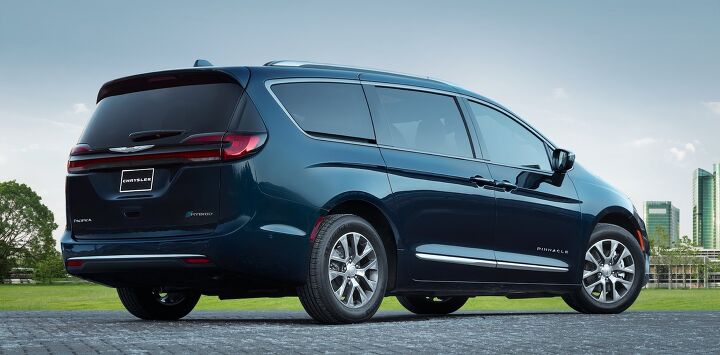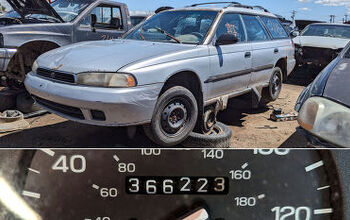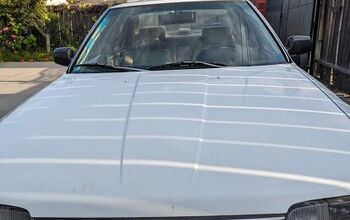Chrysler Slings Updates at Pacifica for 2024

While the majority of Americans have long since decamped in favor of crossovers and SUVs, there remains a dedicated cadre of buyers committed to the family minivan. For 2024, Chrysler is rewarding them with a smattering of updates to its Pacifica.
It’s not a sea of change, to be sure – no, they aren’t grabbing a couple of Hellcat engines before that line goes dark in December – but they are worth mentioning. The frankly excellent plug-in hybrid variant will be available in two models for 2024, including a Select trim in addition to the spendy Pinnacle and its second-row throw cushions. This decision deletes a few features or makes them optional (power liftgate, ambient lighting, and the like) but opens the plug-in hybrid price point to more customers.
Two new colors are on the palette: Red Hot and Baltic Gray. Heady stuff, we know. The top-rung Pinnacle gets a different hue for its quilted Nappa leather seats as well. A neatly named Road Tripper package is expanded to Touring L (a trim, not long wheelbase) and the Select PHEV, bringing a basket of exterior graphics and jazzy orange accents plus a few blacked-out inserts for those who want to try and assert their dominance in the school pick-up line. Wholly practical gear like an integrated vacuum cleaner, cameras providing a bird’s-eye view of small passengers in rear-facing seats, and vanishing Stow-n-Go seats are all on the docket depending on trim.
If you need a refresher, the standard Pacifica is powered by the ubiquitous Pentastar V6, good here for 287 horses while the plug-in hybrid adds 16-kWh worth of batteries and has a system output of 260 ponies. It can travel up to 30 miles solely on electricity when conditions are right. As with other years, all-wheel drive is available on some gas-powered models.
Through the first half of 2023, Chrysler has recorded 73,845 sales of the Pacifica, a number which isn’t readily broken out into gasoline-powered and plug-in hybrid take rates. Amongst the sprawling Stellantis house, this is a number eclipsing vehicles like the Compass, and Durango, and only about 10k off the mighty Wrangler - proving there are still plenty of customers for a Magic Wagon.
[Images: Stellantis]
Become a TTAC insider. Get the latest news, features, TTAC takes, and everything else that gets to the truth about cars first by subscribing to our newsletter.

Matthew buys, sells, fixes, & races cars. As a human index of auto & auction knowledge, he is fond of making money and offering loud opinions.
More by Matthew Guy
Latest Car Reviews
Read moreLatest Product Reviews
Read moreRecent Comments
- 3-On-The-Tree Old news if it is even true. But from m my time as Firefighter/EMT fighting vehicle fires when it catches fire it is very toxic.
- Akear Chinese cars simply do not have the quality of their Japanese and Korean counterparts. Remember, there are also tariffs on Chinese cars.
- 3-On-The-Tree My experience with turbos is that they don’t give good mpg.
- GregLocock They will unless you don't let them. Every car manufacturing country around the world protects their local manufacturers by a mixture of legal and quasi legal measures. The exception was Australia which used to be able to design and manufacture every component in a car (slight exaggeration) and did so for many years protected by local design rules and enormous tariffs. In a fit of ideological purity the tariffs were removed and the industry went down the plughole, as predicted. This was followed by the precision machine shops who made the tooling, and then the aircraft maintenance business went because the machine shops were closed. Also of course many of the other suppliers closed.The Chinese have the following advantagesSlave laborCheap electricityZero respect for IPLong term planning
- MaintenanceCosts Yes, and our response is making it worse.In the rest of the world, all legacy brands are soon going to be what Volvo is today: a friendly Western name on products built more cheaply in China or in companies that are competing with China from the bottom on the cost side (Vietnam, India, etc.) This is already more or less the case in the Chinese market, will soon be the case in other Asian markets, and is eventually coming to the EU market.We are going to try to resist in the US market with politicians' crack - that is, tariffs. Economists don't really disagree on tariffs anymore. Their effect is to depress overall economic activity while sharply raising consumer prices in the tariff-imposing jurisdiction.The effect will be that we will mostly drive U.S.-built cars, but they will be inferior to those built in the rest of the world and will cost 3x-4x as much. Are you ready for your BMW X5 to be three versions old and cost $200k? Because on the current path that is what's coming. It may be overpriced crap that can't be sold in any other world market, but, hey, it was built in South Carolina.The right way to resist would be to try to form our own alliances with the low-cost producers, in which we open our markets to them while requiring adherence to basic labor and environmental standards. But Uncle Joe isn't quite ready to sign that kind of trade agreement, while the orange guy just wants to tell those countries to GFY and hitch up with China if they want a friend.



































Comments
Join the conversation
Chrysler removed the spare tire and replaced it with an inflator kit. That removed it from my consideration. I want to tow a camper and not having a spare of some kind is a deal killer.
We have an 18 Limited. No real issues not related to imacting a.coyote other than the aux battery went bad at 20k miles. Last road trip was 3400 miles and averaged 30mpg on the trip. Tows 3500# just fine.